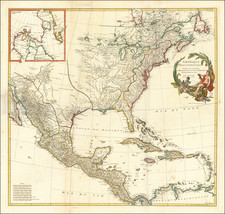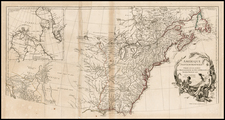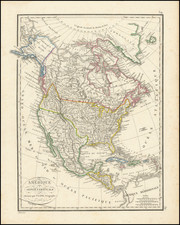Extremely rare first state of J.H. Colton's rare separately published map of North America, which would later become famous during the California Gold Rush.
First issued in 1846, this map would serve as the foundation for one of Colton's most important and influential maps, the 1849 Map of the United States, The British Provinces, Mexico &c. Showing the Routes of the U.S. Mail Steam Packets to California and a Plan of the Gold Region . . . , which Streeter would describe as "one of the rarest California Gold Rush maps."
The present map was likely created following the Oregon Treaty of 1846, which established the boundary between the United States and Canada, which had been left unresolved since the 1818. The map also illustrated a massive "Stovepipe" configuration of the newly annexed Texas, prior to the Compromise of 1850 which would establish its boundaries. The map includes the iconic Pyramid Lake vignette, reflecting Charles C. Fremont's discovery of the lake in 1844, during one of his four exploring expeditions to the west, which would unravel the mysteries of America's "Great American Desert."
The present example extends north to include all of Russian Territory. The subsequent maps would not include the entire printing plate, with Colton adding an inset map of the California Gold regions at the right and a second inset map of the route around South America on the right side. Beginning in 1849, Colton would replace the dotted line showing Fremont's route to the Great Salt Lake region with a solid line showing the the route to California, which would be highlighted in Blue for '49ers using the map as guide map to the gold regions.
The map of North America would be issued again as an uncolored pocket map in 1852, with a portion of the top cut off and the Territorial borders updated.
Rarity
The map is extremely rare. OCLC locates 1 example ( Johns Hopkins University).
We note only the example offered by High Ridge Books in 2011 ($4500).
G. W. & C. B. Colton was a prominent family firm of mapmakers who were leaders in the American map trade in the nineteenth century. Its founder, Joseph Hutchins Colton (1800-1893), was a Massachusetts native. Colton did not start in the map trade; rather, he worked in a general store from 1816 to 1829 and then as a night clerk at the United States Post Office in Hartford, Connecticut. By 1830, he was in New York City, where he set up his publishing business a year later.
The first printed item with his imprint is dated 1833, a reprint of S. Stiles & Company’s edition of David Burr’s map of the state of New York. He also printed John Disturnell’s map of New York City in 1833. Colton’s next cartographic venture was in 1835, when he acquired the rights to John Farmer’s seminal maps of Michigan and Wisconsin. Another early and important Colton work is his Topographical Map of the City and County of New York and the Adjacent Country (1836). In 1839, Colton began issuing the Western Tourist and Emigrant’s Guide, which was originally issued by J. Calvin Smith.
During this first decade, Colton did not have a resident map engraver; he relied upon copyrights purchased from other map makers, most often S. Stiles & Company, and later Stiles, Sherman & Smith. Smith was a charter member of the American Geographical and Statistical Society, as was John Disturnell. This connection would bear fruit for Colton during the early period in his career, helping him to acquire the rights to several important maps. By 1850, the Colton firm was one of the primary publishers of guidebooks and immigrant and railroad maps, known for the high-quality steel plate engravings with decorative borders and hand watercolors.
In 1846, Colton published Colton’s Map of the United States of America, British Possessions . . . his first venture into the wall map business. This work would be issued until 1884 and was the first of several successful wall maps issued by the firm, including collaborative works with D.G. Johnson. From the 1840s to 1855, the firm focused on the production of railroad maps. Later, it published a number of Civil War maps.
In 1855, Colton finally issued his first atlas, Colton’s Atlas of the World, issued in two volumes in 1855 and 1856. In 1857 the work was reduced to a single volume under the title of Colton’s General Atlas, which was published in largely the same format until 1888. It is in this work that George Woolworth (G. W.) Colton’s name appears for the first time.
Born in 1827 and lacking formal training as a mapmaker, G. W. joined his father’s business and would later help it to thrive. His brother Charles B. (C. B.) Colton would also join the firm. Beginning in 1859, the General Atlas gives credit to Johnson & Browning, a credit which disappears after 1860, when Johnson & Browning launched their own atlas venture, Johnson’s New Illustrated (Steel Plate) Family Atlas, which bears Colton’s name as the publisher in the 1860 and 1861 editions.
J.H. Colton also published a number of smaller atlases and school geographies, including his Atlas of America (1854-56), his Illustrated Cabinet Atlas (1859), Colton’s Condensed Cabinet Atlas of Descriptive Geography (1864) and Colton’s Quarto Atlas of the World (1865). From 1850 to the early 1890s, the firm also published several school atlases and pocket maps. The firm continued until the late 1890s, when it merged with a competitor and then ceased to trade under the name Colton.









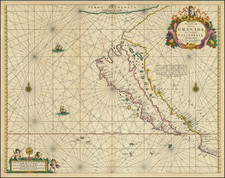
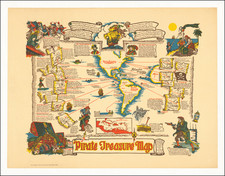
![[ Sir Edmund Halley's Observations on the Variation of the Compass ] A New and Correct Chart of the Western and Southern Oceans Shewing the Variations of the Compass According to the latest and best Observations [with text:] The Description and Uses Of A New and Correct Sea-Chart of the Western and Southern Ocean, Shewing the Variation of the Compass](https://storage.googleapis.com/raremaps/img/small/98400.jpg)
